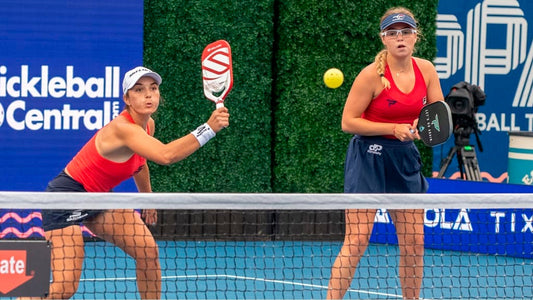
Pros and Cons of Stacking in Pickleball
Share
"The harder the battle, the sweeter the victory." - Les Brown
In the evolving world of pickleball, players are constantly seeking strategies to gain a competitive edge. One such strategy that has gained popularity, particularly in doubles, is “stacking.”
Stacking involves two players on the same team positioning themselves in a way that allows the players to stay on their preferred side of the court, regardless of who is serving. While this tactic can be effective, it also comes with its own set of challenges. In this blog, we’ll explore the pros and cons of stacking when serving in pickleball to help you decide if stacking is the right strategy for your game.
What is Stacking?
Stacking is a positioning strategy used in doubles pickleball where players on the same team both start on the same side of the court. Typically, this occurs when a doubles team is made up of a right-handed player and a left-handed player but can also happen when one player or both prefers playing on either the left side (forehand dominant) or the right side (backhand dominant). This allows the team to play from their dominant sides and potentially gives them an advantage in court coverage and shot selection.
When serving from the opposite side than playing, the player starts in the serving position while their teammate stands between the server and the sideline. Once the player serves, he/she quickly moves back to their preferred side and their teammate moves to the center of the baseline on their side. The team can maintain these positions throughout their serves. Once their serve ends, the players must always return to their rightful sides of the court when the opposite team is serving.
The Pros of Stacking
1. Playing to Your Strengths
Stacking allows players to stay on their preferred or dominant side of the court, which can lead to more consistent and powerful shots. When players are comfortable, they’re likely to perform better, making this strategy particularly effective for teams with distinct forehand and backhand strengths.
2. Enhanced Team Coordination
With each player consistently covering the same side of the court, communication and coordination can improve. Players know their roles, leading to fewer mix-ups and better coverage of the court, which can be particularly advantageous during fast-paced rallies.
3. Maximizing Offensive Play
Stacking can help set up offensive plays by allowing players to take advantage of their dominant side. This can lead to more aggressive and effective shot-making, putting pressure on the opponents and increasing the chances of winning points.
4. Confusing Opponents
When executed well, stacking can confuse opponents, especially those not familiar with the tactic. The unusual positioning might cause opponents to misjudge shots or react slower, giving the stacking team a strategic edge.
The Cons of Stacking
1. Complex Movement Patterns
Stacking requires precise movement and coordination, especially after the serve. If players are not well-practiced in this strategy, it can lead to confusion, slower reactions, and even open up gaps on the court that the opponents can exploit
2. Risk of Exposure
While stacking can create offensive opportunities, it also exposes the stacking team to potential weaknesses. Opponents who understand the strategy may target the open space on the court or use drop shots and lobs to exploit the shifting positions, catching the stacking team off guard.
3. Increased Physical Demand
Constantly shifting sides and repositioning after each serve can be physically demanding, especially in long matches. This increased movement can lead to fatigue, which might affect performance later in the game.
4. Difficulties with Left-Right Balance
If one player is significantly stronger than the other in terms of agility and shot-making, stacking can sometimes lead to an imbalance. The weaker player might struggle to cover their side effectively, leading to a breakdown in the team’s overall strategy.
Game Point
Stacking when serving in pickleball is a double-edged sword. When used correctly, it can enhance team coordination, play to your strengths, and confuse opponents. However, it also comes with challenges, including the need for precise movement, the risk of exposure, and increased physical demands. Whether stacking is right for you depends on your team’s skill level, communication, and understanding of the game.
If you’re considering incorporating stacking into your strategy, it’s essential to practice it thoroughly and communicate clearly with your partner. Like any tactic, it’s most effective when executed with confidence, communication, and precision.
See you on the courts!



